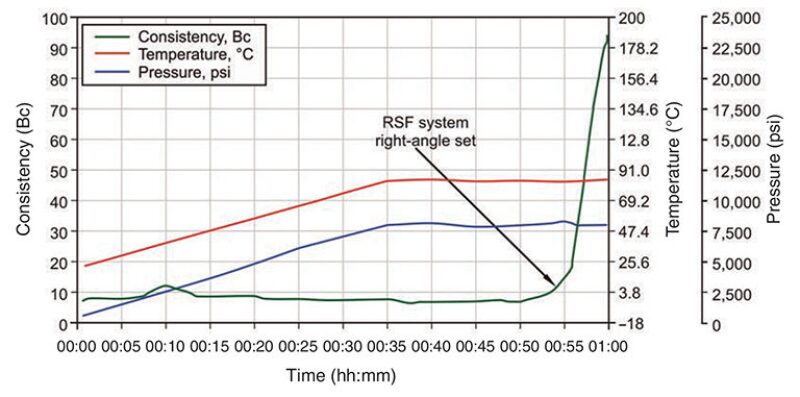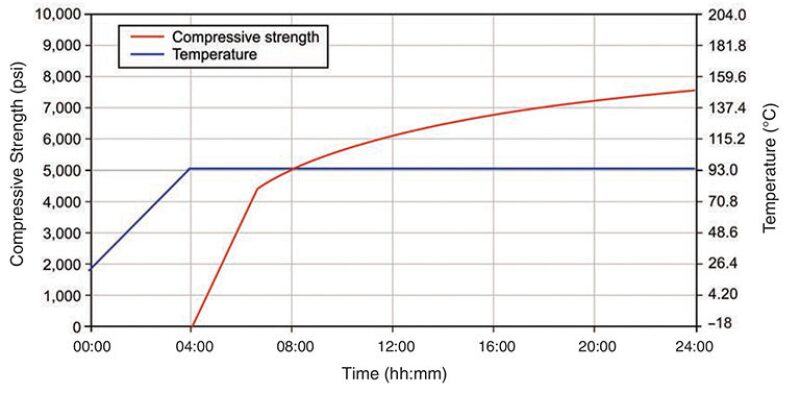This paper discusses a rigid-setting-fluid (RSF) system that has proved successful for curing severe dynamic and static losses, pumping treatments through the drillstring bottomhole assembly (BHA) (no trip out required), because of its highly controllable fast-setting properties. In addition to drilling applications, this system has also been used to shut off undesired fluid production during offshore workover interventions in extreme cases where conventional cement slurries or polymer-gel systems have yielded little success.
Introduction
Excessive water production from hydrocarbon-producing wells is one of the more serious problems in the oil industry. Water tends to become the dominant produced fluid as hydrocarbon fields mature. Unwanted water production can affect well economics adversely because of water-disposal costs, environmental issues, and reduced hydrocarbon production. Other problems can develop as a result of the undesired water production, including sand production, scale, and corrosion. Water-production problems assume various forms: leaks in casing, producing tubing, or packers; flow behind casing; water coning (or water cresting in horizontal wells); or direct communication from the injector to the producer through high-permeability streaks or natural or induced fractures. Several techniques for controlling water production have been attempted, including mechanical and chemical treatments or combinations of both. This paper describes an innovative temperature-activated RSF system used for water and gas shutoff in near-wellbore (NWB) applications.
Another problem discussed in this paper is severe lost circulation while drilling. Uncontrolled losses to the formation represent a high-cost event during drilling stages, especially in offshore environments. These losses can be classified according to their severity: loss of circulation by filtration (1 to 10 bbl/hr), partial loss (10 to 500 bbl/hr), and total loss (500 bbl/hr or greater). Conventional lost-circulation materials (LCMs) used to control losses include bridging agents, gelling agents, or cementing-type materials. Most of the time, cementing-type materials are left as the final option because they require pulling the drillpipe out of hole and running with a cement stinger, resulting in significant additional cost to the drilling stage. On the contrary, even though most of the bridging and gelling LCMs can be pumped through the BHA, most of the time, they are not suited for high-rate losses. While the discussed RSF was originally developed for conformance applications, its chemical and mechanical properties provide a unique solution for treating severe cases of lost circulation—in particular, those related to natural or induced fractures—while pumping the treatment through the BHA.
Description of the RSF System
The RSF system is a temperature-activated, rigid-setting, fast-setting fluid that exhibits a unique set of properties. The RSF system is an inorganic cement-like setting material that has an exothermic right-angle set; it can undergo a phase change from a liquid to an unpumpable clay in a matter of minutes with zero static gel, with a predictable and reliable activation time. Unlike cement, the RSF system is capable of rapidly developing high compressive strength (up to 3,500 psi in less than 2 hours), creating a plug capable of withstanding high pressure differentials and reducing intervention times significantly. The RSF system is generally used for NWB applications or for fracture shutoff. The RSF is a modified Sorel cement slurry that uses a proprietary processed magnesium oxide and several proprietary chemicals to alter its fluid characteristics. This system is engineered to remain a low-viscosity fluid during placement. It then sets rapidly at a given formation temperature. Once the system sets, it becomes impermeable to water or gas influx, exhibiting zero shrinkage during and after the setting process. It is resistant to hydrogen sulfide (H2S) and carbon dioxide (CO2) degradation. Because of its particle size, the RSF system will not penetrate the matrix of the rock, even in highly permeable formations.
Low-Viscosity Fluid. The RSF system is a low-viscosity fluid typically ranging between 18 and 30 cp, depending on the final fluid formulation. The natural low viscosity of the RSF system allows for downhole placement by several techniques, including bullheading, pumping through coiled tubing or work string, or placement using a dump bailer. When treating lost-circulation problems, it is common practice to pump the fluid to the loss zone by means of the drillstring and BHA. This creates considerable operational and economical value within the drilling sector because there is zero nonproductive rig time associated with pulling the drillstring to surface to rig up a cement stinger. This advantage becomes even more important in offshore environments. Weighting agents, fluid-loss additives, and other chemicals can also be added to the base RSF system to tailor its properties for a particular application, including increasing or decreasing fluid weight, improving fluid-loss-control properties, and increasing the rate of acid solubility.
RSF Rapid-Setting Properties. The RSF system has a right-angle set, which means the system transitions from a liquid to a solid state in a matter of 5 to 10 minutes, depending on final fluid formulation and exposure temperature. Fig. 1 shows a typical plot for the RSF system using a cement consistometer; the test was conducted at 181°F. It displays a right-angle-set transition time of less than 5 minutes. As opposed to conventional cement slurries, the RSF system has no static gel state, prohibiting the migration of fluids in liquid or gas state to pass through it during its transition stage. This is a very important property for gas-shutoff applications.

Controllable and Repeatable Activation in Response to Temperature. The set time of the RSF system can be engineered accurately through the addition of a retarder chemical. The high degree of control of set time is the key to success in many difficult downhole sealing applications. In addition, the RSF undergoes an exothermic reaction during its transition period. The self-generation of heat causes the RSF to experience its right-angle set. The relationship between set time and temperature is linear across the working range of the RSF. This linear relationship provides an element of predictability and reliability when considering the practical use of the RSF at different downhole temperatures.
Tolerance to High Levels of Contamination. The RSF system has been tested to tolerate contamination by drilling or completion fluids. Independent testing by a major oil and gas operator has verified that, even with 50% contamination with water, brine, or oil-based-mud systems, the RSF sets in the same predictable and controllable manner and develops a high level of compressive strength. This natural feature of the RSF is of particular benefit when considering small-volume treatments and the unavoidable contamination that occurs at the lead and tail of a treatment during pumping and placement operations.
Development of High Levels of Compressive Strength. After the RSF system reaches its right-angle set, it continues to develop compressive strength, reaching (in many cases) greater than 4,000 psi in less than 3 hours and an ultimate compressive strength greater than 7,000 psi within 24 hours. Standard cement-laboratory equipment is used to measure compressive strength, as illustrated in Fig. 2. The level of compressive strength attained might not be a significant advantage; in many cases, though, the speed at which a satisfactory compressive strength is achieved is very beneficial when considering the cost of nonproductive time, especially when drilling in offshore environments.

Noninvasive. The RSF system has an average particle size of 5 to 10 μm and is categorized as noninvasive. As a consequence of its particle size, the application of the RSF as a water or gas sealant is limited to NWB applications, such as setting plugs behind or between liners and casing strings, sealing off perforation tunnels, or sealing leaking packers. Additionally, the RSF is useful as a remedial treatment for failed or poorly placed cement. For deeper matrix-penetration-conformance problems (i.e., water or gas coning), alternative solids-free sealant systems are better suited, such as polymer-gel systems with deep formation penetration. The RSF can be removed from the wellbore and formation face by drilling or milling most of the set plug, followed by acid removal of the remaining skin at the formation face, typically with 15% hydrochloric acid.
Zero Shrinkage. As opposed to conventional cement slurries, the RSF system displays zero shrinkage during and after setting. Independent testing with standard expansion ring test equipment and procedures concluded that the RSF expands up to 1.8% as part of the curing and setting process. When considering applications for long-term sealing, such as remediating casing leaks or preventing flow of water or gas behind liners, the nonshrinking quality of the RSF is highly beneficial.
Environmentally Acceptable Chemistry. The RSF complies with all regulations for use in offshore environments, including those applicable to the Norwegian North Sea, the strictest legislation in the industry.
Field Application of the RSF System
To date, more than 500 treatments using the RSF system have been performed worldwide to address severe circulation losses while drilling and for conformance problems. Case histories are discussed in detail in the complete paper. Some of the NWB applications in which the RSF has been used are
- Selective isolation of perforations
- Sealing of fracture communication between injectors and producers
- Sealing packer leaks
- Sealing casing leaks
- Eliminating flow of water or gas behind pipe in vertical and horizontal wellbores
- Targeting lost circulation to induced or natural fractures
- Treating sustained casing pressure
- Treating failed liner shoe (remedial)
- Setting annular plugs in vertical and horizontal wellbores
Conclusions
- The RSF system is a low-viscosity, temperature-activated fluid with a controlled right-angle set capable of quickly developing high compressive strength for NWB water and gas shutoff and drilling applications.
- Control of the setting time in cases of severe losses is fundamental to the success of RSF treatments. Accurate control of the setting time is achievable when accurate modeling of the downhole-temperature profile is available.
- Unlike cement, the RSF system is capable of developing high compressive strength rapidly (4,000 psi in less than 3 hours), creating a plug capable of withstanding high pressure differentials and reducing intervention times significantly.
- Laboratory testing has shown that the RSF system is able to tolerate up to 50% contamination with oil- or water-based drilling fluid and still set hard with a controlled set time. Additionally, the RSF system has proved stable under high-concentration H2S and CO2 environments.
- The RSF system has been applied successfully in the following scenarios: controlling severe circulation losses while drilling; permanently or temporarily (depending on the application) shutting off water- and gas-producing zones; formation consolidation; and setting annular plugs in the wellbore (cased-hole and openhole completions in vertical, deviated, and horizontal wells). More than 500 well interventions have been performed with the RSF system.
This article, written by Special Publications Editor Adam Wilson, contains highlights of paper OTC 24417, “A Novel Temperature-Activated, Rigid-Setting Material: Case Histories for Drilling and Conformance Offshore Applications,” by J. Vasquez, SPE, Halliburton, prepared for the 2013 Offshore Technology Conference Brasil, Rio de Janeiro, 29–31 October. The paper has not been peer reviewed. Copyright 2013 Offshore Technology Conference. Reproduced by permission.

